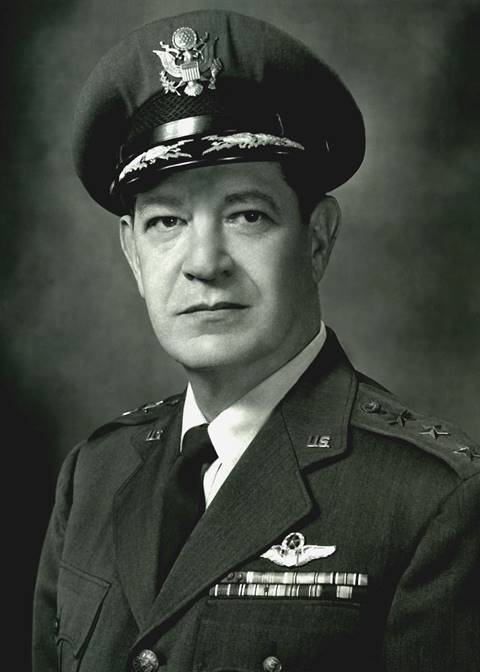Roscoe Charles Wilson was a United States Army Air Forces Officer. At the rank of Colonel he was the overall Project Office to the Manhattan Engineering District from June 1943 to December 1944.
Early Life
Wilson was born in Centralia, Pennsylvania June 11, 1905. After graduating from the U.S. Military Academy in June 1928, he was commissioned to second lieutenant in the Regular Army. In September he began flight training at Brooks Field, Texas. In November of 1929 he was awarded his wings at the Advanced Flying School at Kelly Field, Texas, and transferred to the Air Corps.
Wilson’s first tactical assignment was to the First Observation Squadron at Mitchel Field, New York. In July of 1932 he began his service in the technical and scientific fields when he entered the Air Corps Engineering School at Wright-Patterson Field, in Ohio. Graduating a year later, he was assigned to the Aircraft Branch as the project officer on the B-15 (forerunner of the B-17) and the B-19.
He returned to the U.S. Military Academy to serve as an instructor in the Department of Natural and Experimental Philosophy. He then became an assistant professor there. Here, he assembled a wind tunnel, authored a book, Preliminary Airplane Design, and attended the Air Corps Tactical School.
In June of 1940, Wilson was posted back to Wright Field as the Assistant Chief of the Air Laboratory of the Air Materiel Command. In 1942, he became the Assistant Chief of Development Engineering at the United States Army Air Forces (USAAF) Headquarters in Washington, D.C. In 1943, he became the Chief, reporting to Major General Oliver P. Echols, the head of the Air Material Command.
Manhattan Project
In June of 1943 Henry H. Arnold, designated General Echols as the USAAF liaison with the Manhattan Project. Echols then designated Wilson as his alternative. It was Wilson who became Manhattan Project’s main USAAF contact. Wilson excelled in this liaison position, working closely with Los Alamos personnel on projects related to weapons size and required modifications of the B-29 prototype (serial number 42-6259).
In August of 1944, Wilson aided in the selection of the 393rd Squadron, of the 504th Bomb Group, which became the 509th Composite Group. He also selected Wendover Field in Utah to be their training base. Wilson also requested the procurement of 300 “blockbuster” Pumpkin Bombs for 393rd Squadron training.
In December of 1944 Wilson was named the Chief of Staff of the 316th Bomb Wing at Colorado Springs, which began deployment to Okinawa. The first bomb group element arrived on July 31, 1945. The war ended before this wing was fully deployed to Okinawa and thus did not participate in the bombing of Japan.
General Leslie Groves stated the following, about Wilson:
“Wilson was a most fortunate choice, for his personality and professional competence ensured the smooth co-operation essential to our success. Through his efforts, the necessary air support was always provided by the subordinate Air Force commands, if not willingly, at least without delay. While I can say the same of every other Air Force officer with whom I had any dealings in the project, I have always felt particularly grateful to Wilson, for he had to bear the brunt of all our many minor problems with the Air Force as well as a major responsibility for a number of our principal activities. I am sure that he must have had many difficult moments with his Air Force colleagues, as he denied them, for security reasons, information they considered essential to understand the reasons for his requests.”
Life After the Manhattan Project
In August of 1945, Wilson returned to Air Force headquarters where he served in a succession of staff assignments: Office of the Assistant Chief of Air Staff for Materiel and Supply, the Office of the Deputy Commander of the Air Force, and Office of the Deputy Chief of Staff for Research and Development. He was assigned Temporary Duty (TDY), to participate in the Survey of Atomic Bomb Damage of Japan, from August 26, 1945 to October 12, 1945.
In July of 1947, Wilson became the Deputy Chief of the Armed Forces Special Weapons Project. This military agency was responsible for atomic weapons. In this post he had the additional duties of Air Force Representative to the Military Liaison Committee, between the Defense Department, and the Atomic Energy Commission. In 1950, he was transferred to Headquarters for the U.S. Air Force and continued to serve as Air Force member of the Military Liaison Committee, and the Research and Development Board.
Wilson continued to work with the Air Force throughout the 1950s. In 1951, he became the commandant of the Air War College at Maxwell Air Force Base in Alabama. He served in the United Kingdom from 1954 to 1957, commanding the Third Air Force, and working as the Chief of Military Assistance Advisory Group.
On August 1, 1957 he took up duties in the scientific and technical field when he was assigned as an Air Force member in the Weapons Systems Evaluation Group. In 1958 he was assigned as the Deputy Chief of Staff, and promoted to temporary lieutenant general. He was responsible for the research and technology program of the Air Force.
In 1961, Wilson retired. After his military retirement, he became the President and Chairman of Allied Research in Concord, Massachusetts, and a defense contractor. In 1963, he retired from these positions and moved to Louisville, Kentucky. He passed away on August 21, 1986 at the age of 81, and is interred at the Zachary Taylor National Cemetery.
Wilson is rated Command Pilot and Senior Aircraft Observer. He has been awarded an American Defense Service Medal, an American Theater Medal, a WWII Victory Medal, an Asiatic-Pacific Campaign Medal, and two bronze campaign stars (New Guinea Ryukyu-Okinawa).





